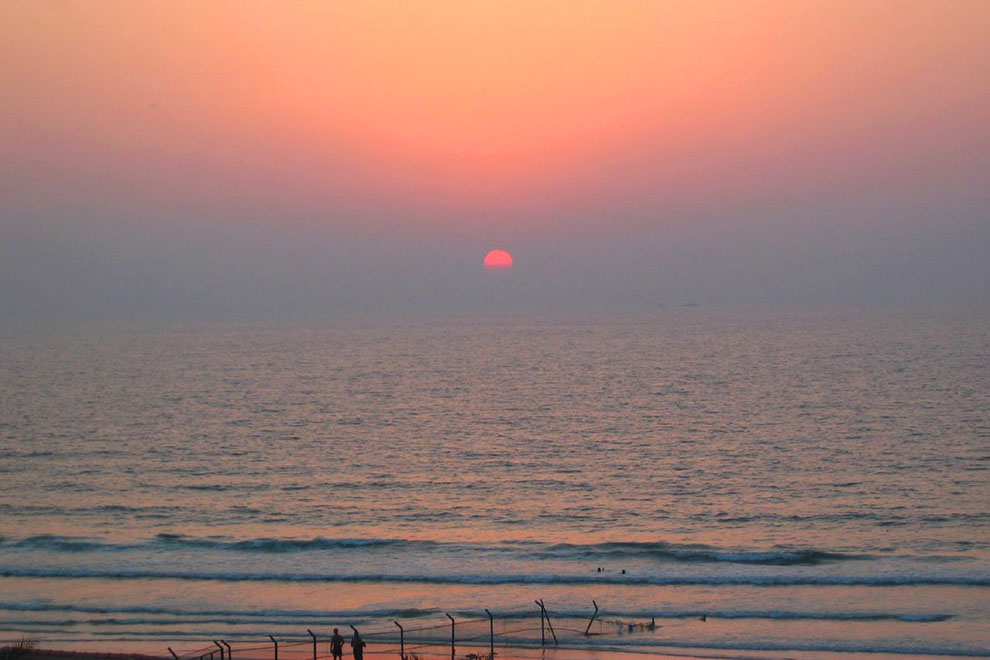On a very hot day in late July, the temperature in the Kuwaiti town of Mitribah reached 54ºC, the highest ever recorded in the eastern hemisphere. Across the Persian Gulf, Fujairah in the United Arab Emirates was experiencing what looked like a relatively cool 36ºC. Thanks to blistering humidity, though, the “heat index” for Fujairah registered 60ºC.
Heat index might not be a well-known term, but it describes how the weather feels to us rather than how it feels to the mercury. Designed back in 1979, it incorporates the effect of relative humidity, and assumes we’re wearing light clothing. At 50 per cent humidity, 30ºC feels like 31ºC; at 90 per cent it feels like 40ºC. The more moisture in the air, the hotter it seems to us and the higher the heat index.
And there’s an extra factor affecting our perception. For every rise of 1ºC, air can hold 7 per cent more moisture. So the amount of moisture in the air is potentially much higher at 35ºC than, say, 25ºC. This makes 90 per cent humidity much harder to bear at 35ºC than at lower temperatures.
The heat index has variants. Australia’s Bureau of Meteorology uses an index of apparent temperature, a mixture of temperature, humidity and wind speed. Although it isn’t reported in the official forecast, the apparent temperature is calculated regularly at most observational sites, and may well be a better indicator of what’s going on outside. Canadian meteorologists prefer the humidex, which directly uses the dew point, the temperature at which the air will be saturated, instead of a derived relative humidity. Then there’s the wetbulb globe temperature, which takes into account radiation, cloud cover and wind speed. While the exact calculations, these indices are effectively measuring the same thing.
Although the heat index is a pretty useful metric, it has its limits. Regardless of the combination of temperature and humidity, the heat index values calculated according to the most up-to-date conversion tables go no higher than 58ºC. So Fujairah’s 60ºC was literally off the charts.
This is not the first time the index has been breached. Bandar Mahshahr reached a value of 60ºC around the same time as Fujairah thanks to a slightly higher temperature but slightly lower humidity levels. And just last year, the same Iranian city reached a whopping heat index of 74ºC, which is 28ºC warmer than the measured air temperature. The highest reading ever was 81ºC in July 2003 in Dhahran, Saudi Arabia.
Such oppressive conditions are nothing short of dangerous. Our core body temperature must stay at around 37ºC for us to function normally. If it rises by just 2 to 3ºC, heat stroke is on the cards. Another 2ºC and death is extremely likely. Our main cooling mechanism, sweating, is extremely important here, as it allows our body to cool via the evaporation of water off the surface of the skin. When it is a dry heat, this mechanism is effective. But when the air is hot and humid, this mechanism fails, since the air is near its water-holding capacity, permitting very little, or no, evaporation.
This means you will need to rely on other ways to keep our temperature down if you find yourself in these extreme conditions. Exercising is out of the question, as is working outdoors. If you can, subject yourself to a cool breeze and plenty of shade and don’t move around a lot. Fans are effective in humid conditions or in temperatures below the high 30s, though less so when temperatures climb above 40ºC. Keeping up your water intake is essential, and a cold shower or dip in a pool, of course, will also help keep you cool.
Places like Bandar Mahshahr, Fujairah and Mitribah, as well as much of the Middle East, are no strangers to such sweltering conditions. Although the corresponding heat index was lower than the actual temperature (thanks to the dry desert air), Baghdad declared a four-day holiday in July last year when temperatures reached 50ºC. Many places are heavy reliant on air conditioning – in Dubai, even the bus stops are enclosed and air-conditioned. In Iraq, though, electricity supply is irregular, making it difficult to cool down in these dangerous conditions.
While the recent temperatures and heat index recordings in the Middle East are no doubt extreme, they are expected at this time of the year, at least to a certain extent. But we should not get complacent. The warning signs in recent events should be grabbing our attention.
There is irrefutable evidence that the world is warming, and with that comes the certainty that extreme temperatures will occur more often. A small shift in average temperature is all it takes to see a large increase in extremes. Right now, we’re heading for a globe that will be 3 to 5ºC warmer than before the industrial revolution by 2100. A warming of 7ºC will seriously call into the question the ongoing habitability of some regions; extreme heat stress will no longer be a rare, or once-per-season occurrence. If Bandar Mahshahr, Fujairah and Mitribah are already experiencing intolerable conditions, what will they be experiencing by 2100, and beyond? And how will they cope?
Then there is the rest of the world. Over the past decade numerous deadly heatwaves have occurred in Australia, Europe, Russia, India and Pakistan. Many of the associated deaths could have been prevented by public education about how to stay cool, as well as greater access to enabling resources.
Of course, this is not a one-size-fits-all issue. Developed countries generally have a greater adaptive capacity, but underlying cultural behaviors may be tough to change. In developing countries, on the other hand, cool working environments and dwellings, and in some cases clean drinking water, are in short supply. But one thing is clear – if nothing is done, more lives will be lost. •




